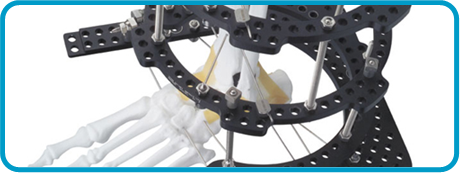Limb restoration is a gradual process that helps to restore a patient's bone and soft tissue to normal alignment, length and function. While there are many reasons a patient would choose to have this type of procedure, the primary indications include trauma, congenital deformities and bone or joint infection.
Your orthopedis uses ILIZAROV surgery to provide limb restoration. This remarkable technique uses a device called the TAYLOR SPATIAL FRAME TM to take advantage of the body's natural ability to grow healthy new bone tissue.
There are two main phases to the ILIZAROV procedure: limb lengthening/correction and consolidation.

ILIZAROV lengthening/correction refers to the period of time it takes to 'grow the bone.' This initial phase begins after the surgeon cuts the bone and attaches the TAYLOR SPATIAL FRAME fixator. During this time, you will be working with the physician and your team to make gradual adjustments to the device, which increases the gap between the bone segments, adding 'length' to the total limb. Over a period of months, new bone tissue will grow in the gap, ultimately hardening the area between the segments of the original bone.
When your surgeon is satisfied with the length and position of the new bone, the consolidation phase begins. During this phase, the bone tissue matures and becomes solid. You still wear the TAYLOR SPATIAL FRAME fixator, but you will not make adjustments. The consolidation phase is the longest part of the ILIZAROV process.
◊ Trademark of Smith & Nephew